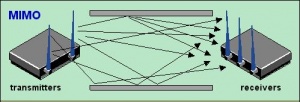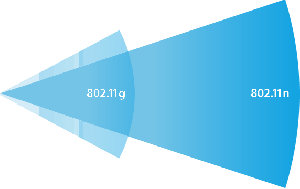WLAN Standard 802.11n
From Computing and Software Wiki
WLAN Standard 802.11n is the latest version of the 802.11 wireless networking standard with 802.11g and 802.11b as predecessors. 802.11n boasts a raw data rate of 600 Mbps; a massive increase from 802.11g's 54 Mbps. To achieve this, 802.11n implements multiple-input multiple-output operation, channel bonding and frame aggregation, among others.
Contents |
Techniques
Multiple-Input Multiple-Output (MIMO)
MIMO uses multiple antennas at the transmitter and receiver which provides the ability to use spatial division multiplexing, multipath signals and space-time block coding.
Spatial division multiplexing (SDM) spatially multiplexes multiple independent data streams that are transferred within one spectral channel of bandwidth. Each spatial stream requires an antenna at both the receiver and transmitter. As the number of antennas increase the number of spatial data streams increase and, in turn, the amount of throughput. The throughput goes up linearly to the number of antennas added. Two antennas (four total, two at the receiver, two at the transmitter) double throughput, three triple it, four quadruple it. The maximum number of antennas 802.11n supports is four.
Multipath signals are the reflected signals arriving at the receiver some time after the line of sight transmission has been received. In 802.11a/b/g protocol versions these reflected signals were treated as interference and the ability to recover information from the signal was hindered. MIMO uses these reflected signals to increase the ability to recover information that was sent in the signal.
Space-time block coding is a feature of MIMO system where the multiple antennas are used to increase the range of the signal. Space–time block coding is a technique that transmits multiple copies of a data stream across a number of antennas.
Channel Bonding
Channel bonding, or 40 MHz, increases the channel bandwidth to 40 MHz from the 20 MHz used in 802.11a/b/g. This mode of operation uses two adjacent 20 MHz bands increasing the number of subcarriers to 108 from 52 in 802.11a/b/g and doubles the bandwidth.
Frame Aggregation
Frame aggregation is a feature of the media access control (MAC) layer in 802.11n. There are two things aggregated in 802.11n: the MAC Service Data Units (MSDUs) and MAC Protocol Data Units (MPDUs). Aggregation takes these units, packs many of them together and averages them over multiple frames, reducing overhead. This, in turn, increases the user level data rate.
Other Notes
Backwards Compatibility
Like 802.11g supported mixed modes with 802.11b/a, 802.11n will support mixed modes with 802.11a/b/g. However, using mixed mode with 802.11a/b/g legacy devices will reduce data throughput just as it currently does with 802.11g and 802.11b mixed modes.
Approval
802.11n hasn't actually been approved yet. This is expected to be done by the IEEE-SA RevCom in Jan 2010. Despite this, many manufacturers have released "Draft N" products. These manufacturers will either have to hope that the final version of 802.11n will not be significantly different than what it is now or release a firmware update to make their devices compatible with the final version of the protocol.
References
1. http://en.wikipedia.org/wiki/Wireless_N
2. http://www.wirevolution.com/2007/09/07/how-does-80211n-get-to-600mbps/
3. http://en.wikipedia.org/wiki/Space%E2%80%93time_block_code
4. http://www.computerworld.com/action/article.do?command=viewArticleBasic&articleId=9019472
See Also
External Links
--Mordecm 21:32, 6 April 2009 (EDT)



